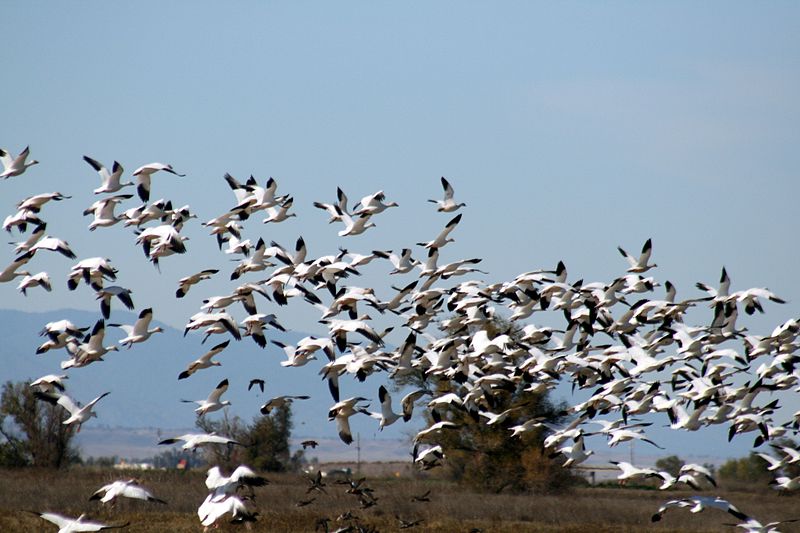Avian cholera strikes geese
Roughly two thousand sick birds collapse in Idaho: Should chickens be worried?
JoAnna Klein • April 1, 2015

Geese migrating from Mexico and the southern U.S. to Alaska dropped dead over Idaho last month. [Image credit: WikiCommons user Brocken Inaglory]
The sky is falling! The sky is falling!
Over 2,000 migrating snow geese fell dead from the sky over Idaho last month. The Idaho Department of Fish and Game announced March 16 that avian cholera is likely to blame. Rapidly spread through soil and water, this bacterial infection threatens local wildlife that may feed on the dead birds. As authorities and volunteers rushed to collect the carcasses, I couldn’t help but wonder: If Chicken Little were hit with a goose instead of an acorn, would it live to tell the king?
According to the National Wildlife Health Center, avian cholera is the most important infectious disease to threaten wildfowl in North America. Caused by an infection from the bacterium Pasteurella mutocida, avian cholera kills quickly and spreads swiftly among birds in close wetland quarters. In some cases, birds die within 12 hours of infection: Biologists say some of these geese likely died mid-flight.
“The important thing is to quickly collect as many of the carcasses as possible, to prevent other birds from feeding on the infected birds,” said Idaho Fish and Game regional supervisor Steve Schmidt in the press release.
He’s worried about the 20 eagles in the area, but I’m still thinking about chickens. Yeah, I know they don’t typically live in wetlands, but bear with me: Chickens eat everything. People have documented chickens eating a dead bird whole, even baby birds.
Biologists at the U.S. Geological Survey say some wild geese — in one study, 5 percent — carry the bacterium and pass it on to other birds and animals through direct contact or through water and soil.
Unlike avian flu, avian cholera is not much of a threat to other mammals, and even less so to humans. The U.S. Geological Survey’s National Wildlife Health Center says the most affected birds are gulls, crows and coots, which are birds that look like black ducks with white spoons on their foreheads. Merck, in its widely used medical manuals, has prioritized the birds most susceptible to avian cholera, and chickens make the list. Turkeys and waterfowl are more susceptible than chickens, and older chickens and those of certain breeds are more susceptible than others.
Of course, Merck is likely looking at chickens in farms that catch the disease from rodents and mites, not geese. Although it’s unlikely, animals infected from geese on the lake could travel, for example, to a place like the Merril Poultry Farm, three hours away from where most of the snow geese were found in Mud Lake. (To my knowledge, Merril Poultry Farm has reported zero incidents of avian cholera in chickens since the snow geese fell over Idaho).
Chickens can and do get avian cholera, but I could find no evidence of a chicken catching avian cholera from a goose — or a chicken catching it from something else that caught it from a goose and traveled to a chicken yard. And there’s also no evidence I could find of a chicken eating a goose, let alone a chicken eating a goose in Mud Lake.
There are a few versions of the story of Chicken Little, each with a slightly different moral. Chicken Little runs around after getting hit with an acorn and tells everyone the sky is falling. In the end, either everything is actually fine, or a fox eats them all. But the most important message of the story is to avoid overreacting and think logically. So would Chicken Little make it to tell the king? Eh, probably, but only because he likely wasn’t hit by a goose.